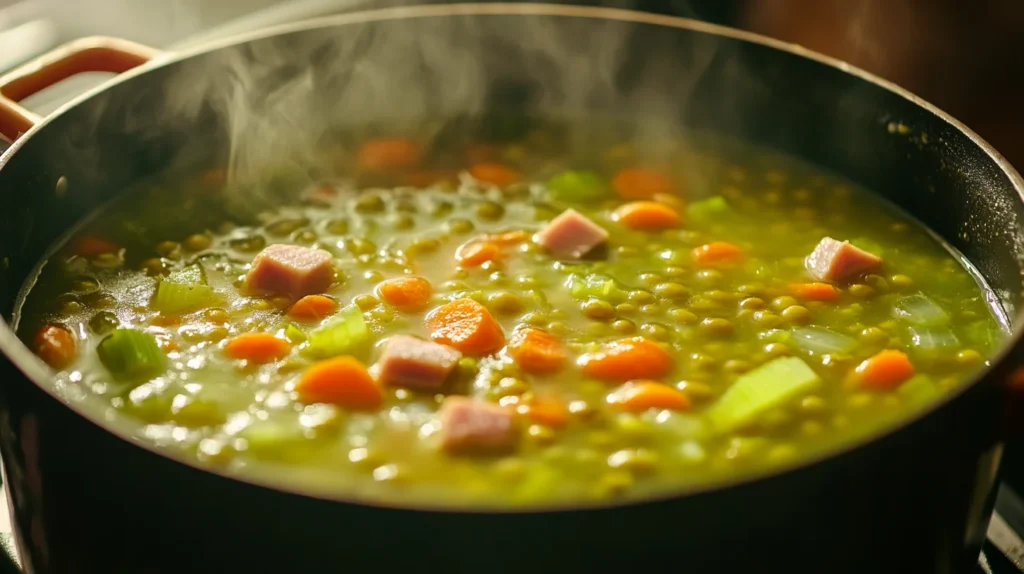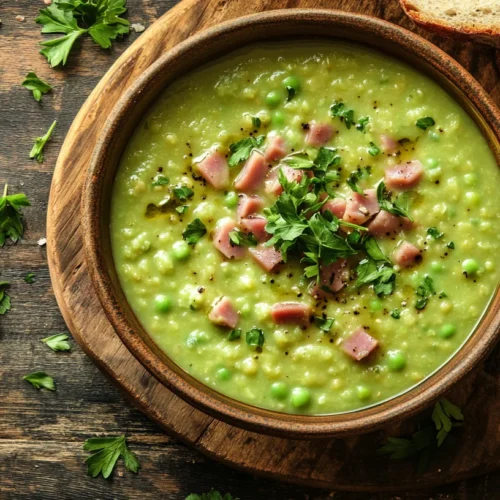Nothing warms the heart and soothes the soul quite like a steaming bowl of split pea and ham soup. This timeless comfort food has been a household favorite for generations, offering not just hearty nutrition but also deep, rich flavors that feel like a hug in a bowl. Whether you’re whipping up a pot on a chilly evening or using up leftovers from a holiday ham, this dish is simple, satisfying, and deeply nourishing.
More than just a tasty meal, split pea and ham soup holds cultural significance across many countries—from the hearty peasant food of medieval Europe to the smoky, soul-satisfying versions found in North America. It’s a dish that tells a story, often made with humble ingredients that transform into something magical through slow cooking and love.
In this article, we’ll explore every facet of this classic soup: its origins, health benefits, best preparation methods, creative variations, and more. Whether you’re a seasoned home cook or a beginner learning the ropes, you’ll find everything you need here to make the best split pea and ham soup of your life.

History and Origins of Split Pea Soup

From Ancient Peasants to Modern Palates
The origins of split pea and ham soup stretch back thousands of years. In ancient civilizations such as Egypt, Greece, and Rome, dried peas were a staple food. These legumes were cheap, filling, and easy to store, making them perfect for feeding large families or entire armies. The dried peas we now know as “split peas” became especially popular during the Middle Ages when European peasants relied heavily on these hearty legumes for survival during long, harsh winters.
In fact, the word “pottage” was commonly used to describe slow-simmered meals of legumes and root vegetables—split pea soup being a classic version of this dish. With the rise of agriculture, peas were cultivated and consumed widely across Europe, especially in countries like England, Germany, and the Netherlands.
Evolution in American Cuisine
Split pea soup made its way to North America with early European settlers. Over time, it adapted to regional tastes and available ingredients. In the United States, ham hocks, smoked ham bones, and leftover ham became key components of the dish—offering a savory, meaty backbone that perfectly complements the earthiness of the peas.
In particular, the soup became a staple in New England and the Midwest, where long winters required warming, nutritious meals. It was also embraced by the U.S. Navy and Army as a rationed meal because it was cheap, shelf-stable, and easy to make in large quantities.
Global Variations
Around the world, you’ll find intriguing takes on split pea and ham soup:
- France: Known as “soupe de pois cassés,” it often includes leeks, carrots, and herbs like thyme and bay leaf.
- The Netherlands: “Erwtensoep” or “snert” is a thicker version served with smoked sausage, often eaten the next day for enhanced flavor.
- Canada (Quebec): “Soupe aux pois” is a traditional pea soup made with yellow split peas and salt pork or ham.
- India: While not called split pea soup, dals (like chana dal) have similar textures and use spices like turmeric, cumin, and coriander.
Health Benefits of Split Pea and Ham Soup
Nutritional Value of split pea and ham soup
split pea and ham soup are a powerhouse of fiber, protein, and essential vitamins. One cup of cooked split peas contains:
- 16 grams of protein
- 16 grams of dietary fiber
- Iron, potassium, and folate
The high fiber content makes this soup excellent for digestive health and cholesterol management. split pea and ham soup are also low in fat, gluten-free, and rich in plant-based nutrients.
Protein and Minerals in Ham
Ham, especially bone-in or smoked varieties, adds not just flavor but a solid dose of protein, iron, zinc, and B vitamins to the soup. Using a ham bone or leftover shank also infuses the broth with collagen and minerals that boost your immune system and support joint health.
It’s worth noting, however, that ham can be high in sodium, so using low-sodium broth or rinsing the meat can help balance the saltiness.
Why It’s Great for Heart and Gut Health
Thanks to its blend of legumes and lean meat, this soup hits a rare nutritional sweet spot:
- Heart Health: The soluble fiber helps lower LDL cholesterol.
- Digestive Health: The fiber promotes regular bowel movements and a healthy gut microbiome.
- Satiety: It’s a filling meal that supports weight management by keeping you full longer.
Main Ingredients Explained
Yellow vs Green Split Peas
Both yellow and green split peas are great for soup, but they offer slightly different flavors:
- Green Split Peas: Sweeter, earthier flavor. Most common in American recipes.
- Yellow Split Peas: Milder, nuttier. Preferred in Scandinavian and French versions.
They cook similarly, so the choice often comes down to color preference and recipe tradition.
The Best Cuts of Ham for Soup
To get the most out of your soup, choose from the following ham options:
- Ham Bone: Best for flavor and depth. Use it after carving a baked ham.
- Ham Hocks: Smokier, meatier, and rich in collagen.
- Diced Cooked Ham: Ideal for quick cooking and easy serving.
- Smoked Ham Shank: A good mix of meat and bone for slow simmering.
For extra flavor, try browning your ham before adding it to the pot.
Herbs and Vegetables to Enhance Flavor
Split pea and ham soup is more than just two ingredients. Aromatics and herbs make the difference:
- Onions, Garlic, and Celery: The classic flavor base (aka mirepoix).
- Carrots: Add natural sweetness and color.
- Bay Leaf and Thyme: Essential herbs for that savory backbone.
- Parsley and Chives: Optional fresh herbs for garnishing.
- Black Pepper and Smoked Paprika: Spices that pair well with ham’s richness.
Don’t forget a splash of apple cider vinegar or lemon juice at the end to balance the flavors.
How to Cook the Perfect Split Pea and Ham Soup

Traditional Stovetop Method
The classic stovetop approach is a tried-and-true way to get a deep, well-developed flavor in your split pea and ham soup. Here’s a step-by-step breakdown:
- Sauté Aromatics: Start with olive oil or butter in a large soup pot. Sauté chopped onions, garlic, celery, and carrots until soft and fragrant.
- Add Ham and Herbs: Stir in diced ham or a ham bone, along with bay leaves, thyme, and black pepper.
- Add Peas and Broth: Rinse the split peas, then add them to the pot along with low-sodium chicken or vegetable broth.
- Simmer Low and Slow: Cover partially and let it simmer on low for 1.5 to 2 hours. Stir occasionally to prevent sticking.
- Check Texture and Season: Once peas are tender, remove bay leaves and ham bone. Shred any remaining meat and return it to the pot. Adjust seasoning to taste.
This slow simmering method helps the flavors develop naturally and results in a rich, comforting texture.
Slow Cooker Instructions
Using a slow cooker makes this dish nearly effortless, and it’s perfect for busy days:
- Prep Ingredients: Dice veggies and rinse split peas.
- Layer in Slow Cooker: Add all ingredients (peas, broth, veggies, ham, and herbs) to the slow cooker.
- Cook on Low for 8 Hours: Let the magic happen. Stir once or twice if you’re nearby.
- Blend Optional: You can partially blend the soup with an immersion blender for a smoother texture before serving.
The slow cooker gives a wonderfully creamy consistency as the peas break down gradually over time.
Instant Pot Version
If you’re short on time, the Instant Pot or pressure cooker is your best friend:
- Sauté First: Use the “Sauté” setting to soften onions, garlic, carrots, and celery.
- Add Ingredients: Stir in split peas, ham, herbs, and broth.
- Pressure Cook: Seal and cook on High Pressure for 15 minutes. Allow a natural release for about 10 minutes.
- Finish and Serve: Stir well, season to taste, and garnish with herbs.
This method gives you that long-simmered flavor in a fraction of the time!
Tips for a Thicker, Creamier Texture
Cooking Time & Simmering Tricks
Split Pea and Ham Soup naturally break down as they cook, but the right technique can boost creaminess:
- Simmer Uncovered for the Last 20 Minutes: This reduces liquid and intensifies flavor.
- Stir Frequently Toward the End: This helps some peas dissolve into the broth.
- Mash with a Spoon: Gently mash against the pot sides to release starch and thicken the base.
Blending Techniques
If you prefer a smooth soup, blending is your go-to method:
- Immersion Blender: Easy and efficient for partial or full blending right in the pot.
- Stand Blender: For ultra-smooth texture, but be careful when blending hot liquids—do it in batches and vent the lid slightly.
- Combination Method: Blend half and mix it back in to keep some chunks for texture.
Using Leftover Ham Bone
Don’t toss that Split Pea and Ham Soup bone! It’s a flavor goldmine:
- Adds Collagen and Gelatin: Creates body and richness in the soup.
- Infuses Smokiness: Especially if the bone is from a smoked ham.
- More Meat: After simmering, you can strip additional meat and add it back to the pot.
Just remember to remove the bone before serving!
Storage, Freezing & Reheating
How Long Does It Last in the Fridge?
Split pea and ham soup stores well in the fridge for up to 5 days when kept in an airtight container. The flavors actually improve after a day or two, making it ideal for leftovers.
- Store in Glass or BPA-Free Plastic: For freshness and safety.
- Cool Before Refrigerating: Let the soup reach room temperature first.
Best Practices for Freezing Split Pea and Ham Soup
This soup freezes exceptionally well, making it a meal-prep hero:
- Portion Before Freezing: Use small containers or freezer bags laid flat for easy stacking.
- Label and Date: Helps track freshness.
- Use Within 3 Months: Best quality if consumed within this time frame.
Note: The Split Pea and Ham Soup will thicken in the freezer. Just add a bit of broth or water when reheating.
Reheating Without Losing Flavor
To reheat, choose one of the following:
- Stovetop: Reheat over low heat, stirring occasionally. Add broth if needed.
- Microwave: Use a microwave-safe bowl. Cover and stir halfway through to avoid hot spots.
- Slow Cooker: Great for reheating large batches while keeping the texture intact.
Avoid overheating, which can dull the flavors and break down the Split Pea and Ham Soup too much.
Creative Variations and Additions
Vegetarian or Vegan Version
While Split pea and ham soup is traditional, you can easily make a flavorful vegetarian or vegan split pea soup by using the right combination of ingredients:
- Replace ham with smoked paprika or liquid smoke for that familiar smoky essence.
- Use vegetable broth instead of chicken or ham stock.
- Add mushrooms or diced tofu to boost the protein content.
- For a creamy finish, stir in a splash of coconut milk or a spoonful of cashew cream.
Don’t skip the aromatics—onions, garlic, carrots, and celery are still crucial to building flavor.
Spicy Southwest Twist
Give your Split pea and ham soup a bold, spicy makeover with some Tex-Mex flair:
- Add diced green chilies, jalapeños, or a dash of cayenne pepper.
- Replace ham with chorizo or smoked turkey sausage.
- Include corn, black beans, and roasted red peppers for texture and southwestern flavor.
- Top with fresh cilantro, lime juice, and crushed tortilla chips for garnish.
This version is great if you’re looking to jazz things up while staying grounded in comfort food.
French Canadian Style (Soupe aux pois)
This traditional version from Quebec uses yellow split peas and salt pork or ham hock, creating a rustic and hearty dish:
- Often simmered with onion, bay leaf, and savory, a common herb in Canadian cuisine.
- Typically thicker and chunkier in texture.
- Sometimes includes barley or potatoes for extra body.
Serve it with a slice of toasted country bread and a smear of mustard for a classic pairing.
Serving Suggestions and Pairings
Best Bread and Sides
What’s Split pea and ham soup without something to dip?
- Crusty Sourdough: The tangy crust complements the savory richness.
- Garlic Bread: Adds bold flavor and a crunchy contrast.
- Buttermilk Biscuits: Southern-style comfort in every bite.
- Cornbread: Especially good with spicy or smoky variations.
For a light side, try a simple green salad with vinaigrette to balance the heaviness of the soup.
Wine or Drink Pairings
Believe it or not, Split pea and ham soup pairs well with more than just water or soda:
- White Wines: A dry Riesling or Sauvignon Blanc cuts through the soup’s richness.
- Light Reds: Try a Pinot Noir or Gamay for a fruit-forward contrast.
- Beer: A malty ale, amber beer, or stout complements smoky ham flavors.
- Non-Alcoholic Options: Sparkling apple cider or iced green tea offers freshness without overwhelming the palate.
Perfect for Leftovers
Split pea and ham soup gets even better the next day. It thickens, the flavors deepen, and it becomes ideal for:
- Lunchboxes: Packed hot in a thermos.
- Quick Dinners: Reheat with a splash of broth.
- Soup and Sandwich Combos: Pair with grilled cheese or ham and Swiss on rye.
Pro Tip: Add a new topping—like croutons, shredded cheese, or fresh parsley—to make leftovers feel fresh again.
Common Mistakes to Avoid
Overcooking or Undercooking Peas
Split pea and ham soup generally don’t need soaking, but they still require gentle simmering to break down. If overcooked, they turn mushy; if undercooked, they stay grainy.
- Simmer until peas are tender and breaking apart but not mush.
- Check occasionally and stir to monitor texture.
Not Seasoning Enough
Peas soak up a lot of liquid and flavor, so you must season generously:
- Add salt gradually—especially if using salty ham or broth.
- Include acidity like lemon juice or vinegar at the end to brighten the flavor.
- Don’t forget about black pepper, herbs, and garlic for depth.
Taste and adjust near the end of cooking, not just at the beginning.
Adding Salt Too Early
Salt affects how legumes cook—if added too soon, it can make the peas stay firm. Instead:
- Add salty ingredients (like ham or broth) early.
- Hold off on additional salt until peas are nearly done.
- Taste, adjust, and let simmer a bit more to fully integrate the flavors.
Split pea and ham soup for Special Diets
Gluten-Free Adjustments
The great news is that split pea and ham soup is naturally gluten-free, as long as you’re cautious about the following:
- Broth or Stock: Choose a certified gluten-free version. Some store-bought broths contain wheat-based thickeners.
- Ham: Check labeling if using packaged or processed ham. Some contain fillers or flavorings with gluten.
- Bread Pairings: Serve with gluten-free bread or cornbread to keep the whole meal safe for gluten-sensitive guests.
With these simple steps, your soup will be both hearty and gluten-friendly.
Low-Sodium Tips
If you’re cooking for someone on a low-sodium diet, you can still enjoy rich, delicious soup by making a few adjustments:
- Use unsalted broth: Gives you total control over salt levels.
- Rinse the ham: Especially if it’s been brined or smoked.
- Add natural flavor boosters like garlic, onion, herbs, lemon juice, and a splash of apple cider vinegar.
- Avoid processed meats: Use lean, fresh cuts or unsalted ham shank when possible.
This makes the soup suitable for those with hypertension or heart conditions—without sacrificing flavor.
Diabetic-Friendly Version
Split peas have a low glycemic index and are packed with fiber, which helps regulate blood sugar. To make your soup even more diabetes-friendly:
- Avoid adding starch-heavy ingredients like potatoes or white rice.
- Stick to lean meats with lower fat content.
- Load up on non-starchy vegetables like spinach, celery, and bell peppers.
- Use herbs and spices for flavor instead of sugar or extra salt.
Serve in smaller portions with a protein-rich side for balanced blood sugar levels.
Kids and Split pea and ham soup

Making It Appealing for Children
Kids can be picky about texture and color, so making Split pea and ham soup appealing might take a little creativity:
- Blend it Smooth: Pureeing the soup gives it a creamy, familiar texture similar to mashed potatoes.
- Add Fun Shapes: Serve with alphabet pasta, goldfish crackers, or toast cut into stars or hearts.
- Give It a Fun Name: Call it “Green Power Soup” or “Superhero Stew” to spark curiosity.
Presentation matters—serve in a colorful bowl with a swirl of sour cream or shredded cheese on top.
Pureed Versions for Toddlers
Split pea and ham soup is excellent for toddlers because it’s easy to chew and packed with nutrition:
- Fully blend the soup to remove any chunks or strings from the ham.
- Make it creamier with unsweetened almond milk or yogurt.
- Cool it before serving and offer it in small spoonfuls.
Introduce new flavors early while still keeping it mild and digestible.
Fun Toppings to Add
Getting kids involved in topping their own bowls is a great way to increase interest:
- Crumbled bacon (for crunch)
- Grated cheese
- Mini croutons
- Chopped parsley
- Sweet corn or peas
Make a mini topping bar at the table and let kids customize their soup—it turns eating into an activity!
Cooking with Leftovers

Using Leftover Ham in Soup
Split pea and ham soup is one of the best ways to use up holiday:
- Dice the ham and freeze in 1-cup portions to use in soups year-round.
- Simmer the ham bone with peas and vegetables for extra flavor.
- Combine with broth and aromatics to create a deep, savory base.
Leftover ham brings natural seasoning and texture without additional prep.
Turning Soup into a Casserole
Thick leftover Split pea and ham soup? Don’t toss it—transform it!
- Stir in some cooked quinoa, rice, or pasta.
- Pour into a baking dish, top with breadcrumbs and cheese, and bake until bubbly.
- Add extra veggies or shredded chicken for variety.
This makes a completely new meal from yesterday’s pot.
Making Split Pea Croquettes
Feeling creative? Try making split pea croquettes or fritters:
- Chill the soup until very thick.
- Mix in breadcrumbs, cheese, and an egg.
- Shape into patties and pan-fry until golden.
Serve with a tangy yogurt sauce or mustard dip—perfect for lunchboxes or party snacks!
Expert Chef Tips for Split pea and ham soup
Pro Kitchen Hacks
Take your soup from basic to brilliant with these chef-approved tricks:
- Deglaze your pot after sautéing vegetables with a splash of white wine or vinegar to lift fond (browned bits).
- Add a Parmesan rind during simmering for subtle umami richness.
- Use a mix of green and yellow peas for more depth and color contrast.
Balancing Flavors with Acidity
Split peas and ham are both earthy and savory, so they need a hint of acid to balance the palate:
- Try a splash of apple cider vinegar, lemon juice, or even a dash of balsamic vinegar.
- Stir in acidity at the end to keep it fresh and bright.
This lifts the flavor and cuts through any heaviness.
Achieving the Perfect Consistency
Consistency is key in a memorable soup:
- For thin soup, add more broth or water.
- For thick soup, continue simmering uncovered or mash/blend.
- If soup separates after storing, stir gently while reheating to reincorporate.
Finding that “just right” texture may take practice, but it’s the mark of a seasoned home cook!
When you’re craving something warm and nourishing, a bowl of Split Pea and Ham Soup is a perfect choice—but don’t stop there. For more soul-soothing meals, try the deeply flavorful Italian Penicillin Soup, or pair your soup with a side of Cheesy Pepperoni Stromboli for the ultimate comfort food duo. Looking for a sweet finish? The Decadent Chocolate Ricotta Tiramisu brings a rich cocoa twist to classic dessert lovers, while leftovers from today’s meal can be reimagined just like the clever transformation behind Pistachio Kunafa Brownies.
Can I make this soup without the ham hock?
Yes, absolutely! If you don’t have a ham hock or prefer not to use one, you can still make a flavorful Split pea and ham soup. Consider these alternatives:
Diced cooked ham: Adds meatiness and smoky flavor.
Smoked turkey leg or wing: A great substitute that still brings depth and richness.
Vegetarian version: Use smoked paprika or a drop of liquid smoke for that “meaty” essence without any meat.
A ham hock enhances texture and flavor, but it’s not essential—plenty of delicious, meat-free versions exist.
Why aren’t my Split pea and ham soup getting soft?
This is a common issue and usually boils down to one of a few factors:
Old peas: Dried peas have a long shelf life, but older batches can take much longer to soften or may never fully break down.
Acidic ingredients: Adding tomatoes, vinegar, or citrus too early in the cooking process can toughen the peas. Always add acidic ingredients at the end.
Hard water: Minerals in hard tap water can prevent legumes from softening. Use filtered or distilled water if this is a recurring problem.
Not enough cooking time: Split pea and ham soup usually need at least 60–90 minutes of simmering (or 15–20 minutes in a pressure cooker).
Try cooking longer or replacing your peas with a fresh batch if they stay crunchy.
Can I freeze this soup?
Yes, split pea and ham soup freezes beautifully and is one of the best soups for meal prepping. Follow these tips:
Cool completely before freezing.
Store in single-serving portions using freezer-safe containers or bags.
Label with the date and consume within 3 months for best taste.
When reheating, add a little water or broth, as the soup thickens during freezing.
Thaw in the fridge overnight or reheat directly from frozen on the stovetop or microwave.
Why is my soup too thick?
Split peas naturally break down and thicken the soup as they cook, especially once refrigerated. If your soup ends up too thick:
Add broth, water, or milk when reheating.
Stir continuously to loosen up any dense patches.
Avoid over-blending if you prefer a chunkier consistency.
Thicker soup is often considered a sign of a rich, well-made batch—but it should always be easy to ladle and stir.
Conclusion
Split pea and ham soup is more than just a cold-weather staple—it’s a dish rooted in history, nutrition, and pure comfort. Whether you’re simmering a pot on the stove all afternoon or making a quick weeknight version in your Instant Pot, this hearty meal always delivers.
With countless variations, from vegetarian to spicy southwest twists, there’s a version for every palate. And thanks to its simplicity and adaptability, it’s the perfect recipe to keep in your culinary toolbox.
So the next time you have some leftover ham, or you’re simply craving something warm and wholesome, try making this soup from scratch. You’ll not only nourish your body—you’ll warm your soul.

Classic Split Pea and Ham Soup
Equipment
- Large soup pot or Dutch oven
- Wooden spoon
- Knife and cutting board
- Measuring cups and spoons
- Ladle
- Immersion blender (optional)
Ingredients
- 2 tablespoons olive oil or unsalted butter
- 1 medium onion chopped
- 2 cloves garlic minced
- 2 carrots peeled and diced
- 2 celery stalks diced
- 1 lb 450g green split peas, rinsed
- 1 meaty ham bone or 2 cups diced cooked ham
- 6 cups low-sodium chicken broth or water with bouillon
- 1 bay leaf
- 1 teaspoon dried thyme
- Salt and pepper to taste
- 1 tablespoon lemon juice or apple cider vinegar optional, for brightness
- Fresh parsley or chives for garnish optional
Instructions
- Sauté the aromatics:
- In a large soup pot, heat olive oil over medium heat. Add the onion, garlic, carrots, and celery. Cook for 5–7 minutes until softened and fragrant.
- Add peas and ham:
- Stir in the rinsed split peas, ham bone (or diced ham), bay leaf, and thyme.
- Pour in broth and simmer:
- Add chicken broth, bring to a boil, then reduce heat. Cover and simmer for 1.5 to 2 hours, stirring occasionally, until the peas are tender and the soup is thickened.
- Remove bone and season:
- If using a ham bone, remove it, shred any meat, and return meat to the pot. Discard the bone and bay leaf.
- Blend (optional):
- For a creamier texture, use an immersion blender to blend part of the soup.
- Finish and serve:
- Add salt, pepper, and lemon juice to taste. Serve hot, garnished with chopped parsley or croutons.

